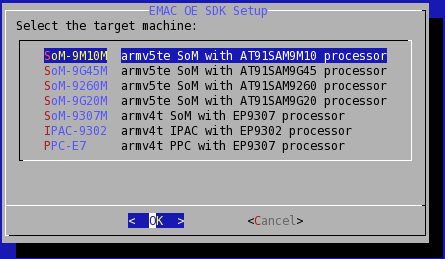Configuring EMAC OE 4.0 SDK
SDK Configuration Script
Before compiling source code on the development machine for the target machine, the toolchain libraries for the target machine must be specified.
-
Open a terminal window
-
Navigate to the SDK directory.
developer@ldc:~$ cd /path/to/sdk/EMAC-OE-arm-linux-gnueabi-SDK_XX.YY/ -
Run the script using the command shown below to produce a menu as shown in Figure 1.
developer@ldc:~$ ./setmachine.sh
-
Select the appropriate target machine type
Remote Upload Set-up
The global.properties file contains the fields necessary to contact and connect to the target board as well as the architecture specific build paths.
-
Obtain the target machine's current IP address by issuing the following command from a shell on the target system:
root@emac-oe:~# /sbin/ifconfig eth0 | grep inet -
Navigate to the projects directory within the SDK.
developer@ldc:~$ cd /path/to/sdk/EMAC-OE-arm-linux-gnueabi-SDK_XX.YY/projects -
Open the global.properties file with a text editor such as vi.
-
The global.properties parameters are shown in Table 1 below.
Configuration variable Description SDKBASE The base directory for the SDK. CC, CXX Exectuable binaries to use for compiling for the C and C++ compiler, respectively. LD_LIBRARY_PATH The path the linker should use to search for shared library files. CFLAGS The flags passed to the compiler to specify target processor architecture, debugging flags, etc. OFLAGS The flags passed to the compiler to specify optimization options to use. TARGET_IP The IP Address of the target machine (needed for uploading the compiled binary to the target machine). LOGIN The user name to use for logging into the target machine. PASSWORD The password to use for logging into the target machine.* WPUT The location of the wputcommand, along with options to pass towput.
For more information on how to connect to the remote system, see the initial connections of the Getting Started Guide.
The password is stored in plain text in this file. If development is taking place in a shared environment (such as a University lab) and secrecy of this password is required, simply ensure that only trusted users have read permission for this file. See Linux manual pages documentation for the chmod, chgrp, and chown commands. The user building the software will need read access to any file associated with the build. |
